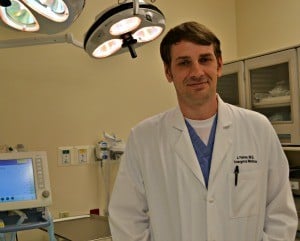Palmer Receives Award for Trauma Simulation
| Aug. 22, 2012 | When a trauma case rolls in a hospital emergency department, split second decisions may mean the difference between life and death for a patient. A UAMS physician who developed a simulation program for practicing those emergency situations was recognized recently for offering an innovative way of teaching preparedness. Jonathan Palmer, M.D., an assistant professor in the Department of Emergency Medicine of the UAMS College of Medicine, received the Innovation in Medical Education Award in May from the Academy of Clerkship Directors in Emergency Medicine of the Society for Academic Emergency Medicine. The award is intended to recognize a junior faculty member for contributions and commitment to medical education. Palmer teamed with staff in the Department of Emergency Medicine and UAMS Simulation Center in 2011 to develop what he called a “trauma ambush” program that allowed physicians and nurses to take part in a mock trauma scenario that they do not know is coming. Two trauma scenarios have been filmed so far. The scenarios were broadcast live to rural hospitals in Arkansas that are part of the AR SAVES telemedicine network as well as to a conference room full of UAMS medical and surgical residents and faculty members. “I was interested in finding a way to simulate trauma cases so we could use them as a teaching tool” Palmer said. “The simulations gave us a chance to practice situations or conditions that don’t occur often – like tourniquet use for example, that we built into a scenario.” In the two filmed scenarios, one showed care for a simulated patient who had been shocked by a power line and then injured further by a fall to the ground. The next scenario involved a penetrating gunshot injury with damage to a major artery causing a large amount of blood loss. “Sharing the trauma scenarios with the rural hospitals allows us to build bridges, which is especially important in the new statewide trauma system,” said Talmage Holmes, Ph.D., M.P.H., an associate professor and research director in the Department of Emergency Medicine. Smaller hospitals may not have some of the less commonly needed equipment or resources used in some trauma cases, Palmer said. With the trauma simulations, UAMS physicians can demonstrate alternatives, such as how a sheet can be used temporarily in place of a pelvic binder, a piece of equipment used to stop internal bleeding in patients with pelvic injuries. Follow up debriefing sessions allow those watching the broadcast to ask questions or get more information on techniques or trauma resources. Medical students observing the trauma simulations get a sense of how a trauma case is run in an emergency department. Palmer said in the typical trauma case, a core trauma team will include as many as five or six faculty and resident physicians and several nurses or other specialists. Each person in the room has a role in quickly assessing different aspects of the patient, communicating with other team members and delivering medical care. Terry Collins, R.N., UAMS director of trauma services, helped him develop the simulation idea, Palmer said. He also credited trauma surgeons Ron Robertson, M.D., a professor in the College of Medicine’s Department of Surgery and Mike Sutherland, M.D., an assistant professor of surgery, with assisting with the program and participating in the simulations. Palmer said he was thrilled to be recognized with the award, adding that several members of the Emergency Department and Department of Emergency Medicine staff helped make the trauma ambush program a success. He said he hopes the program will continue and grow into a regular event for students and rural hospitals. Palmer is a two-time recipient of the Robert A. Fisher Excellence in Teaching Award given by UAMS emergency medicine resident physicians annually to a faculty member. He also is a two-time recipient of a Red Sash Award, an annual teaching award based on nominations by senior medical students.
|
